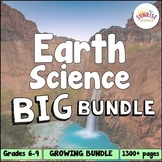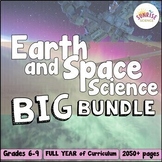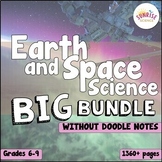Earth and Space Science Introductory Unit | Satellites
- PDF
- Google Apps™
- Internet Activities

Also included in
- Looking for fun, student-centered, and engaging activities to add into your Earth Science curriculum? This is all of my resources for teaching Earth Science! This is a bundle of engaging resources including editable NGSS-aligned blended learning units, Cornell Doodle Notes, digital Pixel Art contentPrice $223.00Original Price $316.63Save $93.63
- This is a bundle of all of my resources for teaching Earth and Space Science at the middle school level! These resources include a mix of Cornell Doodle Notes, lab activities, inquiry activities, digital lessons and units, projects, and pixel art digital content review activities.✨ Please note thatPrice $327.00Original Price $450.24Save $123.24
- This is a bundle of all of my resources for teaching Earth and Space Science at the middle school level, EXCLUDING the Cornell Doodle Notes. The resources in this bundle include a mix of digital lessons and units, lab activities, inquiry activities, projects, review activities, and assessments.✨ ThiPrice $259.00Original Price $369.00Save $110.00
Description
This 3-week introduction to Earth and Space Science blended learning unit is a series of lessons help students understand how various Earth scientists study different aspects of Earth's systems, how to differentiate between observations and inferences and make detailed observations and evidence-based inferences, describe ways that Earth's spheres (geosphere, biosphere, hydrosphere, atmosphere, and cryosphere) interact and how scientists study them, identify the Earth’s continents and oceans, hemispheres, and important lines, make observations about regions of Earth’s surface using Google Earth, and explain how satellites including the International Space Station are used to study Earth’s systems. This unit provides students a great foundation for their studies in Earth and Space Science.
What is a blended learning unit? Blended learning combines online educational materials and opportunities with physical place-based classroom methods. This resource is the digital 'backbone' component of the unit that is editable and flexible for incorporating hands-on activities and labs and for varying the delivery of lessons to accommodate whole-class discussion, or small group, partner, or individual work.
But PLEASE NOTE! This is NOT a "webquest"! These lessons are written to be a sequential journey through the content and the teacher will still be facilitating the lessons. Students are not left to complete these lessons on their own. The teacher can use best practice pedagogy to have students interacting in whole-class discussions and small group work throughout the unit!
The variety of activities that make up this unit include:
- making observations from the soil from a 'mystery planet', collaboratively inferencing about the planet's features, and creating a model of the features of the mystery planet to share in a class feedback gallery
- completing a digital interactive lesson about Earth's five spheres (biosphere, geosphere, hydrosphere, atmosphere, and cryosphere)
- learning about the aurora borealis and aurora australis and Earth's superpower-- its magnetic field
- using a Google Form activity to navigate the American Museum of Natural History's Race to the South Pole historical interactive
- completing a series of graphic organizers to label the Earth's continents, oceans, hemispheres, and important latitude and longitude lines
- navigating to and making observations about various amazing places on the globe in a Google Earth Scavenger Hunt
- using Zoom Earth to view live satellite imagery
- analyzing basic data using NASA's Earth Observation maps
- viewing a live interactive of satellite positions
- doing basic research on an assigned satellite to share in a digital class gallery
- predicting, observing, and explaining how water behaves in the micro-gravity environment of the International Space Station
- touring and live-tracking the International Space Station
- designing and building a satellite model
- ... and more!
Throughout this unit, students will engage in:
- modeling activities and feedback galleries
- digital manipulatives and graphic organizers
- predicting, observing, and explaining phenomena
- video clips
- readings
- formative assessments
- summative assessment
- ... and more!
During this unit, students will learn the digital skills of working with Google Docs, Slides, Google Earth, Forms, Drawings, class galleries, and more!
These 9 lessons + cumulative project are organized into separate Google Docs that you will share with your students on Google Classroom. Each of these lessons takes 1 to 2 days to complete. Students will type directly on their copies of these Docs and these are what you will grade for each student.
My students have responded so well to this lesson format because they know what to expect. I love that I can schedule out all of the lessons in Google Classroom and I know what I’m teaching weeks out! You can modify the lessons as you need to. The prep is easy and the grading is so easy too.
This download includes a Unit Overview Google Doc that is for the Teacher. This document has all of the lessons written out in sections (Lesson 1, Lesson 2, Lesson 3, etc.) so that you can see everything in one place. This document notes how many days (40-45 minute periods) each individual lesson will usually take to complete and it contains most of the answers for the activities. This will help you with planning.
Please view the PREVIEW for more visuals of how this unit is organized.
This is a list of the topics/concepts covered in each lesson:
Lesson 1: Types of Earth Scientists; observations vs. inferences
Lesson 2: Scientific Modeling
Lesson 3: Earth's Spheres
Lesson 4: How scientists study Earth
Mini-Lab and CER Lesson
Lesson 5: Earth's magnetic field
Lesson 6: Earth's continents, oceans, hemispheres, and lines
Lesson 7: Using Google Earth
Lesson 8: Satellites that study Earth's systems
Lesson 9: The International Space Station
Project: Design and Build a Satellite
Post-Assessment (and Study Guide Included)
This unit was designed to satisfy the following NGSS Standards: MS-ESS2-1 Earth’s Systems: Develop a model to describe the cycling of Earth’s materials and the flow of energy that drives this process; Interdependence of Science, Engineering, and Technology: Engineering advances have led to important discoveries in virtually every field of science and scientific discoveries have led to the development of entire industries and engineered systems.
I'm confident that this unit will save you TONS of planning time! You will have 3 to 3.5 weeks of editable and flexible curriculum!
Heads up! You can take advantage of a HUGE discount off of this unit and all of my other Earth and Space resources as part of the Earth & Space Science BIG Bundle!
Thanks for looking!
Sunrise Science








